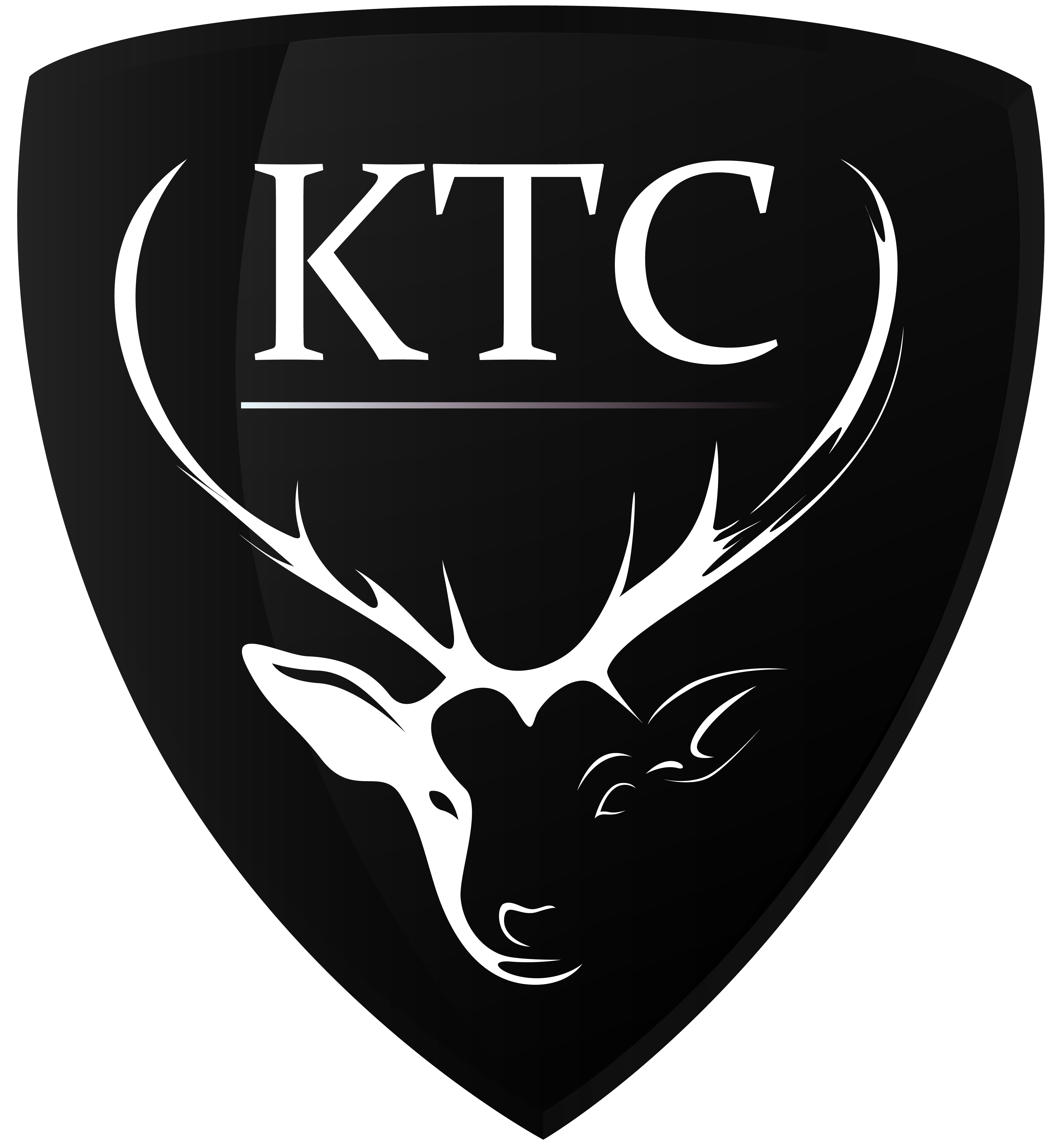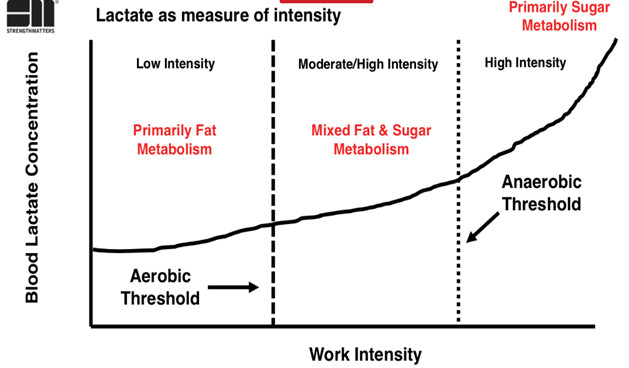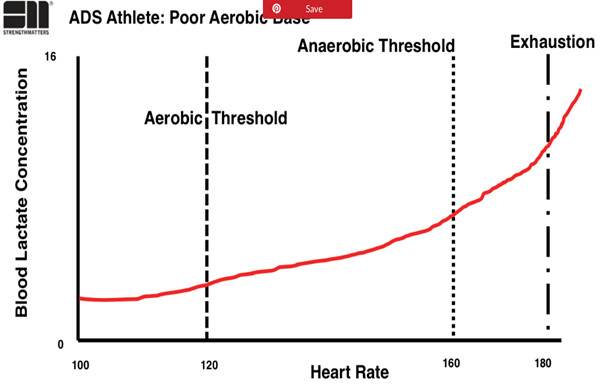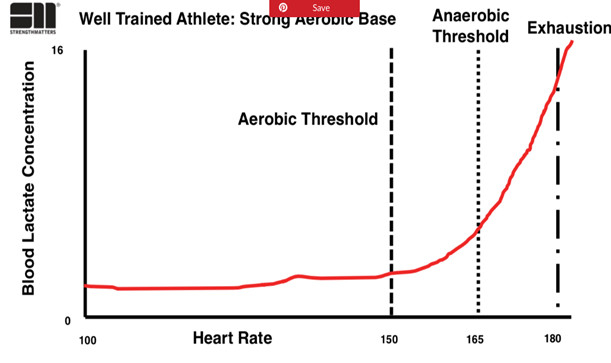COACHING ADVICE
Benefits of group coach sessions
Indoor bike sessions
AEROBIC:
‘AEROBIC’ simply means ‘with oxygen’ (NOT to be confused with ‘Aerobics’, the 1980’s exercise class involving Jane Fonda and legwarmers…!).
Our cells use the oxygen we inhale to break down fats or carbohydrates (in the form of glucose or glycogen) in a series of chemical reactions that then produce energy in the form of ATP (Adenosine TriPhosphate) which enables the muscles to work.
Glucose + Oxygen = Carbon Dioxide + Water + Energy
This is the most effective energy system and can be sustained for long periods (distance running, long bike rides) and breathing is light, can chat away and feel as if you could go all day….
https://www.teachpe.com/anatomy-physiology/aerobic-system-krebs-cycle
https://www.bbc.co.uk/bitesize/topics/zvrrd2p/articles/zth9ng8
https://www.trainingpeaks.com/blog/exercise-metabolism-for-cyclists/
AEROBIC THRESHOLD:
Sometimes referred to as AeT. This is the point when the body stops relying solely on aerobic respiration for energy and starts to use a combination of aerobic (predominantly fat burning) and anaerobic pathways (using the body’s glucose stores – approx. 30 min supply).
It is considered by many experienced coaches to be the most important threshold to train within and that by training the body to become more efficient as using aerobic respiration and have a higher lactate clearance tolerance, thus raising your AeT, you can exercise at a higher intensity for longer.
https://strengthmatters.com/what-is-the-aerobic-threshold-a-beginners-guide/
https://endurancebikeandrun.com/blog/2020/2/6/why-is-aerobic-threshold-important
https://www.polar.com/blog/understand-aerobic-threshold/
ANAEROBIC:
‘ANAEROBIC’ means ‘without oxygen’. Anaerobic respiration also breaks down glucose to provide energy but without using oxygen.
There are two anaerobic energy pathways that can occur – an ATP-PC (ATP-Phosphocreatine) system that can supply almost immediate explosive energy such as for powerlifting or shot put, but only be sustained for 10 seconds – and the Lactic Acid system. Without oxygen the by-products of the cellular chemical reactions cannot be effectively utilised or removed so they build up in the cells/muscles and one of the main by-products is lactic acid.
This energy system can provide high intensity energy for a few minutes only (e.g. sprinting)
https://www.teachpe.com/anatomy-physiology/anaerobic-respiration-lactic-acid
https://www.bbc.co.uk/bitesize/topics/zvrrd2p/articles/zcsbmsg
https://www.trainingpeaks.com/blog/exercise-metabolism-for-cyclists/
ANAEROBIC THRESHOLD:
Sometimes referred to as AT. This is the point when the body stops using aerobic respiration predominantly fat burning) and becomes solely reliant on anaerobic respiration (using the body’s glucose stores – approx. 30 min supply) for energy. After this point the lactate builds up faster than can be removed (requires oxygen to do so) and pain, burning and fatigue are felt in the muscles.
https://www.concept2.com/indoor-rowers/training/tips-and-general-info/anaerobic-threshold
https://strengthmatters.com/what-is-the-aerobic-threshold-a-beginners-guide/
BORG SCALE:
Developed by Gunnar Borg. A subjective rating of 1 – 10 of perceived exertion during exercise.
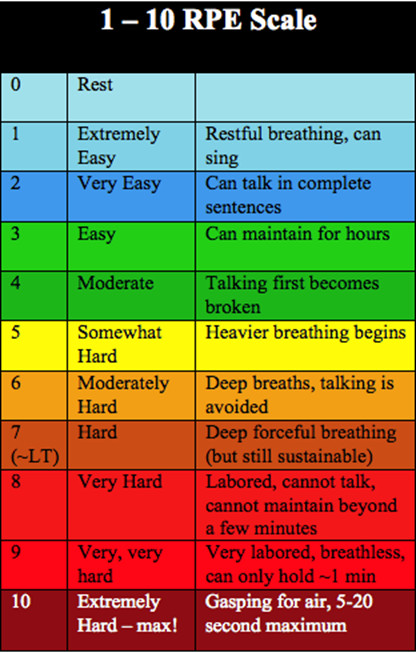
As adapted and utilised by the indoorcyclingassociation USA
CADENCE:
Cadence is the rate at which a cyclist pedals and is measured in Revolutions Per Minute (RPM). A cadence of 60 RPM means that one pedal (for example the right pedal) turns 60 times in a minute.
It is good to practice cycling at different cadences because having a higher cadence improves your cycling efficiency allowing you to pedal faster as you are putting less strain through your muscles with each pedal
stroke, increasing blood flow to the muscles and allowing the aerobic pathway for energy to occur. A low cadence with a high gear can put a lot of strain on the muscles requiring fast-twitch muscles fibres to used, to power the pedals, which require the anaerobic pathways and hence lead to lactic acid state, fatigue and burning and take longer to recover. There are times whilst cycling that you will be required to cycle quickly or find yourself grinding up a hill so train your body to cope with different cadences and different gearings.
https://blog.wahoofitness.com/cycling-cadence-what-is-it-how-to-improve-yours/
CARDIOVASCULAR SYSTEM:
Also known as the circulatory system. Refers to the heart, arteries, veins, capillaries and blood.
The two golden rules of developing the cardiovascular system are:
- Reduce the production of lactate by having a higher aerobic
- Increase the rate of lactate removal from the working muscles by having a fully functioning anaerobic
The first rule is all about maximizing your aerobic threshold. The second rule is about maximizing your anaerobic threshold. Both need to be trained very differently, but both are key to maximizing the cardiovascular system.
https://strengthmatters.com/what-is-the-aerobic-threshold-a-beginners-guide/
ENDURANCE:
In the context of sport, ‘Endurance’ can be defined as the ability to sustain a specific activity (cycling, running, swimming) for a prolonged period of time whilst experiencing a level of physical stress. It is strongly affected by the aerobic/anaerobic energy systems, aerobic and anaerobic thresholds, cardiovascular efficiency, muscle strength, muscle endurance, muscle power and psychological frame of mind and limited primarily by fatigue.
Endurance pace is defined as an “all day pace” or Long Slow Distance pace (see Heart Rate Zones)
https://training4endurance.co.uk/physiology-of-endurance/what-is-endurance/
‘FEELS LIKE…’:
See Borg Scale
FTHR – FUNCTIONAL THRESHOLD HEART RATE:
See LTHR
FTP – FUNCTIONAL THRESHOLD POWER:
The average number of watts/power that a cyclist can sustain over an hour without fatiguing. This can be found by using a power meter and by riding hard (as if in a time trial) for 20 minutes after a long warm-up and then taking 95% of the average power produced. (continued on next page)
It is useful as a guide to setting power training zones and for approximating the anaerobic threshold.
https://www.bicycling.com/skills-tips/a23402043/what-is-ftp-test/
https://www.trainingpeaks.com/blog/power-terminology-for-cycling/
HEART RATE (HR):
Measured in Beats per Minute (BPM)
HEART RATE ZONES:
Usually based on Max individual heart rate (HR) or Lactate Threshold Heart Rate (LTHR). If working off HR zones then be aware that the HR has a delayed response (seconds to minutes occasionally) to the needs of the body and will not immediately change zones when you want to!
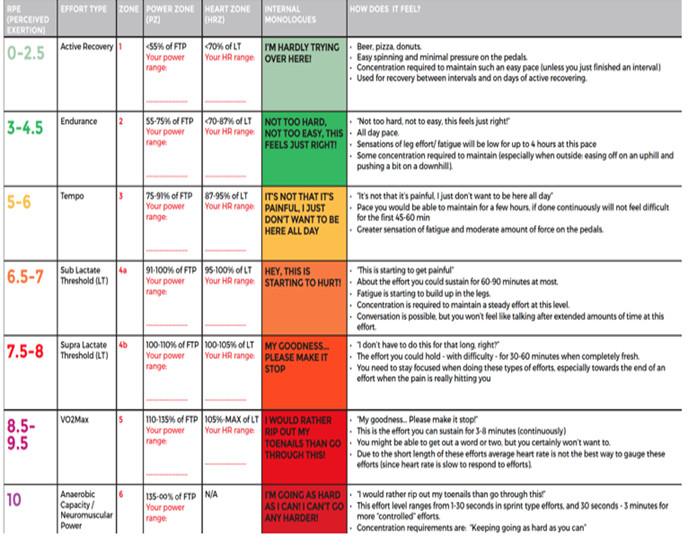
LT = Lactate Threshold
https://www.trainingpeaks.com/blog/power-training-levels/
INTERVALS:
Interval training intersperses high intensity workouts with lighter rest or recovery periods. Often interspersing anaerobic threshold or above workouts with aerobic recoveries.
LACTATE:
Often used interchangeably with lactic acid. Lactate is the electronically charged form of lactic acid produced by the muscle cells (amongst others) following the anaerobic breakdown of glucose for energy.
https://labtestsonline.org.uk/tests/lactate
LACTIC ACID:
Often used interchangeably with lactate. Whilst there is a chemical structural difference between lactic acid and lactate it is of minimal overall difference to the outcome for athletes. When high levels of lactate accumulate in the cells it causes the cell to become more acidic, hence the name lactic acid. Anaerobic respiration (to provide energy) cannot perform very well in an acidic environment so the body is forced to slow down the exertion it is undertaking, allowing aerobic respiration to occur with oxygen getting to the cells to start removing the lactic acid/lactate and other metabolites that have built up. The build-up of lactate and other metabolites cause pain and cramp when their levels become too high (making the athlete slow down or stop) but do not cause delayed onset-muscle soreness over the next few days.
https://www.scientificamerican.com/article/why-does-lactic-acid-buil/
LTHR – LACTATE THRESHOLD HEART RATE:
Also referred to as FTHR (Functional Threshold Heart Rate)
The heart rate that is associated with your individual threshold power or threshold pace. This can be determined by doing a 30 minute time trial and after 10 minutes clicking the ‘lap’ button on your heart monitor/watch/bike computer and using the approximation of your average heart rate for the last 20 minutes as your LTHR.
https://www.trainingpeaks.com/blog/joe-friel-s-quick-guide-to-setting-zones/
https://cyklopedia.cc/cycling-tips/what-is-ftp-in-cycling/
MUSCLE ENDURANCE:
The ability of a muscle or group of muscles to repeatedly exert a force (muscular contractions) over time without fatigue. It can be improved by improving the resistance of slow and fast twitch muscle fibres against fatigue. This can be through improving the aerobic and anaerobic thresholds and through exercises that specifically work on engaging the muscle fibres rapidly and collectively.
https://training4endurance.co.uk/physiology-of-endurance/what-is-endurance/
MUSCLE STRENGTH:
The maximum force that can be exerted in a single effort. Greater muscular strength will make it easier to work at lower intensities of endurance.
https://training4endurance.co.uk/physiology-of-endurance/what-is-endurance/
MUSCLE POWER:
The muscular force exerted over a given time period.
https://training4endurance.co.uk/physiology-of-endurance/what-is-endurance/
NEUROMUSCULAR POWER:
The short intense burst of power that uses the anaerobic ATP-PC system for energy. Lasts for a maximum of 10-15 seconds only and is usually at over 150% of your FTP. Extreme discomfort is felt for those 10-15 seconds but it is important not to neglect training this system as it can be required for a hard-kick on a steep climb or a sprint and is aided by a strong cardiovascular system.
https://blog.tacx.com/power-zones-explained/
POWER ZONE:
Derived from the Functional Threshold Power (FTP). See Heart Rate Zones
https://www.trainingpeaks.com/blog/joe-friel-s-quick-guide-to-setting-zones/
https://www.trainingpeaks.com/blog/power-training-levels/
R.P.E. – RECOMMENDED PERCEIVED EXERTION:
See Borg Scale
SPEED:
This is often used interchangeably between ‘speed’ – as in how fast you can go in a given time or over a given distance and ‘speed’ – how quickly can you turn the pedals. Working at different cadences will help greatly with both of these.
https://www.active.com/cycling/articles/2-workouts-to-boost-your-cycling-speed
https://www.triathlete.com/training/workouts/one-hour-workout-bike-speed-session/
STRENGTH:
How strong your muscles are in cycling. Often refers to legs but the neck, shoulders, arms, core also need to be strong to efficient on the bike.
https://mastersoftri.com/bike-strength-not-power/
STRENGTH – ENDURANCE:
A combination of strength work and endurance work that will improve your aerobic threshold and muscular strength but is in one session. Often using intervals and differing cadences or power/heart zones throughout the session.
https://formfinder.cc/publictips/strength-endurance.php
https://www.cyclingweekly.com/fitness/training/how-to-build-your-cycling-endurance-407292
SWEET SPOT:
This is defined as the cusp between tempo and threshold cycling (cycling at the anaerobic threshold) at 88 – 93% of FTP or 94 – 97% LTHR. It is useful for training for endurance or long time trial events and helps to improve the Anaerobic threshold without requiring a prolonged recovery by the cells.
https://www.bikeradar.com/advice/fitness-and-training/sweetspot-training/
TEMPO:
Described as a brisk pace with conversation possible but halting due to effort (ie not able to flow smoothly)
See Heart Rate Zones
https://www.trainingpeaks.com/blog/power-training-levels/
VO2 (MAX):
VO2 refers to the amount of oxygen inspired in one breath. VO2 Max is the maximum volume of oxygen used during exercise (usually intense exercise). It is said to be the best measure of cardiovascular fitness and is a measure of the efficiency of the aerobic system. (continued on next page)
VO2 max is dependent upon the efficiency to inhale and absorb oxygen, to pump and transport the oxygenated blood around the body and the ability of the muscles to efficiently utilise the oxygen to utilise the oxygen to produce energy for the required muscular contractions to power the pedals.
https://training4endurance.co.uk/physiology-of-endurance/vo2max/



